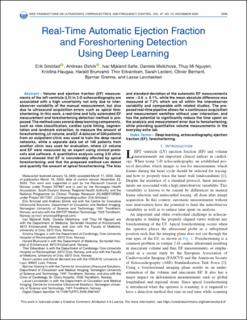| dc.contributor.author | Smistad, Erik | |
| dc.contributor.author | Salte, Ivar Mjåland | |
| dc.contributor.author | Østvik, Andreas | |
| dc.contributor.author | Melichova, Daniela | |
| dc.contributor.author | Nguyen, Thuy Mi | |
| dc.contributor.author | Haugaa, Kristina | |
| dc.contributor.author | Brunvand, Harald | |
| dc.contributor.author | Edvardsen, Thor | |
| dc.contributor.author | Leclerc, Sarah | |
| dc.contributor.author | Bernard, Olivier | |
| dc.contributor.author | Grenne, Bjørnar | |
| dc.contributor.author | Løvstakken, Lasse | |
| dc.date.accessioned | 2021-02-26T07:05:18Z | |
| dc.date.available | 2021-02-26T07:05:18Z | |
| dc.date.created | 2020-04-03T09:02:57Z | |
| dc.date.issued | 2020 | |
| dc.identifier.citation | IEEE Transactions on Ultrasonics, Ferroelectrics and Frequency Control. 2020, 67 (12), 2595-2604. | en_US |
| dc.identifier.issn | 0885-3010 | |
| dc.identifier.uri | https://hdl.handle.net/11250/2730523 | |
| dc.description.abstract | Volume and ejection fraction (EF) measurements of the left ventricle (LV) in 2-D echocardiography are associated with a high uncertainty not only due to interobserver variability of the manual measurement, but also due to ultrasound acquisition errors such as apical foreshortening. In this work, a real-time and fully automated EF measurement and foreshortening detection method is proposed. The method uses several deep learning components, such as view classification, cardiac cycle timing, segmentation and landmark extraction, to measure the amount of foreshortening, LV volume, and EF. A data set of 500 patients from an outpatient clinic was used to train the deep neural networks, while a separate data set of 100 patients from another clinic was used for evaluation, where LV volume and EF were measured by an expert using clinical protocols and software. A quantitative analysis using 3-D ultrasound showed that EF is considerably affected by apical foreshortening, and that the proposed method can detect and quantify the amount of apical foreshortening. The bias and standard deviation of the automatic EF measurements were -3.6 ± 8.1%, while the mean absolute difference was measured at 7.2% which are all within the interobserver variability and comparable with related studies. The proposed real-time pipeline allows for a continuous acquisition and measurement workflow without user interaction, and has the potential to significantly reduce the time spent on the analysis and measurement error due to foreshortening, while providing quantitative volume measurements in the everyday echo lab. | en_US |
| dc.language.iso | eng | en_US |
| dc.publisher | Institute of Electrical and Electronics Engineers (IEEE) | en_US |
| dc.rights | Navngivelse 4.0 Internasjonal | * |
| dc.rights.uri | http://creativecommons.org/licenses/by/4.0/deed.no | * |
| dc.title | Real-Time Automatic Ejection Fraction and Foreshortening Detection Using Deep Learning | en_US |
| dc.type | Peer reviewed | en_US |
| dc.type | Journal article | en_US |
| dc.description.version | publishedVersion | en_US |
| dc.source.pagenumber | 2595-2604 | en_US |
| dc.source.volume | 67 | en_US |
| dc.source.journal | IEEE Transactions on Ultrasonics, Ferroelectrics and Frequency Control | en_US |
| dc.source.issue | 12 | en_US |
| dc.identifier.doi | 10.1109/TUFFC.2020.2981037 | |
| dc.identifier.cristin | 1805117 | |
| dc.relation.project | Norges forskningsråd: 237887 | en_US |
| cristin.ispublished | true | |
| cristin.fulltext | original | |
| cristin.qualitycode | 1 | |

